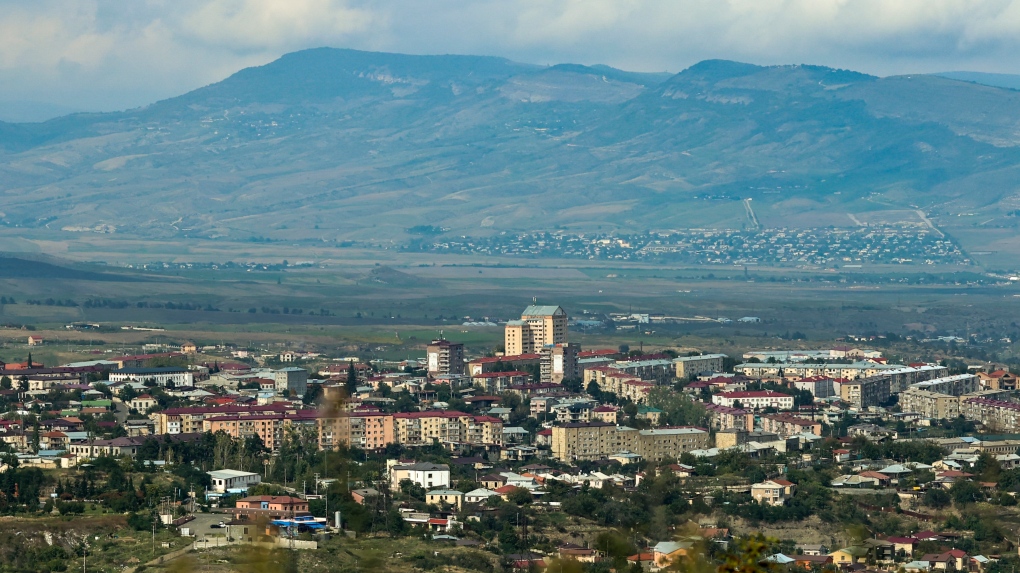Image is of Stepanakert, essentially the capital of Nagorno-Karabakh. It is now a ghost city, and Azerbaijan has recently torn down the parliament building and various other important places. Sourced from this article.
Despite the predictions and assertions of various NATO-aligned commentators that Russia's influence is waning, the opposite generally appears to be occurring. ASEAN has become more strongly aligned with Russia despite claims to the contrary. In Central Asia, there has been a propaganda push to declare that countries there are "emerging from Russia's shadow", while in reality, as Bhadrakumar analyzes, Russia's significant economic growth and ongoing march towards victory in Ukraine is creating opportunities for further integration, not separation, and there are no major political shifts there in terms of Russian ties. And in Niger, Russian soldiers have now entered an airbase which once hosted American soldiers, now kicked out, and generally Russia's diplomacy and economic deals (nuclear power plant construction, military equipment, grain shipments, etc) have accelerated in Africa.
Where Russia's influence has actually seemed to decrease (outside of the West, of course) is in Armenia. Nagorno-Karabakh's remarkably rapid collapse in late 2023 demonstrated that Russia was not willing to escalate things in defense of Armenia to fend off Azerbaijan. One hundred thousand Armenians - most but not all of them in the region - fled in advance to avoid mass persecution, which received remarkably little attention by a West which calls itself overwhelmingly concerned with borders changing due to military action as in Ukraine. Since then, Armenia seems to be on some kind of self-annihilating bender, allured by the potential of Western military and economic deals. Armenia froze its membership in the CSTO due to its failure to protect them, and the head of NATO, Stoltenberg, visited the region in March. The West has offered up hundreds of millions of dollars in assistance to Armenia and is helping them "modernize their military"; given the poor track record of Western military equipment in Ukraine, one wonders why they're even bothering. RAND has advocated for a balancing act; America should, in their eyes, realize that they can't entirely remove Russia's influence but nonetheless should make inroads to protect Armenia from Azerbaijan (which is an interesting position given that Israel provided arms to Azerbaijan to help them take Nagorno-Karabakh).
A quick look at Armenia's geographical position reveals the folly of trying to create some kind of Western outpost. With a hostile Azerbaijan to their east, a very unfriendly (albeit NATO member) Turkiye to their west, an ascendant Iran to their south, and Russia not far from the action, there is little hope of doing much more than causing a little chaos in the hopes it'll momentarily distract Russia while it makes inroads most everywhere else on the planet. The political situation appears miserable for Pashinyan, but there isn't really a popular alternative to take the reins. A truly cursed situation.
The COTW (Country of the Week) label is designed to spur discussion and debate about a specific country every week in order to help the community gain greater understanding of the domestic situation of often-understudied nations. If you've wanted to talk about the country or share your experiences, but have never found a relevant place to do so, now is your chance! However, don't worry - this is still a general news megathread where you can post about ongoing events from any country.
The Country of the Week is Armenia! Feel free to chime in with books, essays, longform articles, even stories and anecdotes or rants. More detail here.
Please check out the HexAtlas!
The bulletins site is here!
The RSS feed is here.
Last week's thread is here.
Israel-Palestine Conflict
Sources on the fighting in Palestine against Israel. In general, CW for footage of battles, explosions, dead people, and so on:
UNRWA daily-ish reports on Israel's destruction and siege of Gaza and the West Bank.
English-language Palestinian Marxist-Leninist twitter account. Alt here.
English-language twitter account that collates news (and has automated posting when the person running it goes to sleep).
Arab-language twitter account with videos and images of fighting.
English-language (with some Arab retweets) Twitter account based in Lebanon. - Telegram is @IbnRiad.
English-language Palestinian Twitter account which reports on news from the Resistance Axis. - Telegram is @EyesOnSouth.
English-language Twitter account in the same group as the previous two. - Telegram here.
English-language PalestineResist telegram channel.
More telegram channels here for those interested.
Various sources that are covering the Ukraine conflict are also covering the one in Palestine, like Rybar.
Russia-Ukraine Conflict
Examples of Ukrainian Nazis and fascists
Examples of racism/euro-centrism during the Russia-Ukraine conflict
Sources:
Defense Politics Asia's youtube channel and their map. Their youtube channel has substantially diminished in quality but the map is still useful.
Moon of Alabama, which tends to have interesting analysis. Avoid the comment section.
Understanding War and the Saker: reactionary sources that have occasional insights on the war.
Alexander Mercouris, who does daily videos on the conflict. While he is a reactionary and surrounds himself with likeminded people, his daily update videos are relatively brainworm-free and good if you don't want to follow Russian telegram channels to get news. He also co-hosts The Duran, which is more explicitly conservative, racist, sexist, transphobic, anti-communist, etc when guests are invited on, but is just about tolerable when it's just the two of them if you want a little more analysis.
On the ground: Patrick Lancaster, an independent and very good journalist reporting in the warzone on the separatists' side.
Unedited videos of Russian/Ukrainian press conferences and speeches.
Pro-Russian Telegram Channels:
Again, CW for anti-LGBT and racist, sexist, etc speech, as well as combat footage.
https://t.me/aleksandr_skif ~ DPR's former Defense Minister and Colonel in the DPR's forces. Russian language.
https://t.me/Slavyangrad ~ A few different pro-Russian people gather frequent content for this channel (~100 posts per day), some socialist, but all socially reactionary. If you can only tolerate using one Russian telegram channel, I would recommend this one.
https://t.me/s/levigodman ~ Does daily update posts.
https://t.me/patricklancasternewstoday ~ Patrick Lancaster's telegram channel.
https://t.me/gonzowarr ~ A big Russian commentator.
https://t.me/rybar ~ One of, if not the, biggest Russian telegram channels focussing on the war out there. Actually quite balanced, maybe even pessimistic about Russia. Produces interesting and useful maps.
https://t.me/epoddubny ~ Russian language.
https://t.me/boris_rozhin ~ Russian language.
https://t.me/mod_russia_en ~ Russian Ministry of Defense. Does daily, if rather bland updates on the number of Ukrainians killed, etc. The figures appear to be approximately accurate; if you want, reduce all numbers by 25% as a 'propaganda tax', if you don't believe them. Does not cover everything, for obvious reasons, and virtually never details Russian losses.
https://t.me/UkraineHumanRightsAbuses ~ Pro-Russian, documents abuses that Ukraine commits.
Pro-Ukraine Telegram Channels:
Almost every Western media outlet.
https://discord.gg/projectowl ~ Pro-Ukrainian OSINT Discord.
https://t.me/ice_inii ~ Alleged Ukrainian account with a rather cynical take on the entire thing.

 is out as defens minister
is out as defens minister
